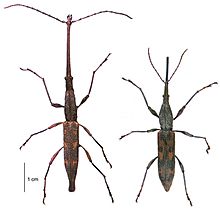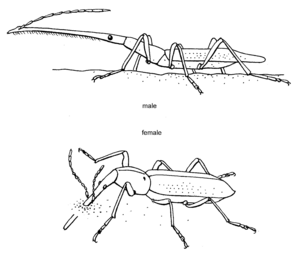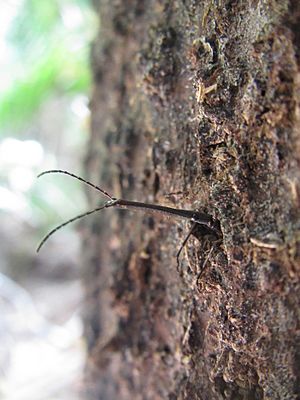New Zealand giraffe weevil facts for kids
Quick facts for kids Lasiorhynchus barbicornis |
|
|---|---|
 |
|
| Male and female New Zealand giraffe weevil | |
| Scientific classification | |
| Kingdom: | |
| Phylum: | |
| Class: | |
| Order: | |
| Superfamily: | |
| Family: |
Brentidae
|
| Subfamily: |
Brentinae
|
| Genus: |
Lasiorhynchus
|
| Species: |
L. barbicornis
|
| Binomial name | |
| Lasiorhynchus barbicornis (Fabricius, 1775)
|
|
The New Zealand giraffe weevil, Lasiorhynchus barbicornis, is a special type of weevil found only in New Zealand. It's known for its very long snout, especially in males. This beetle is the longest in New Zealand.
Male weevils can grow up to 90 mm long, while females reach about 50 mm. Males use their long snouts, called a rostrum, to fight over females. Smaller males sometimes sneak in to mate without fighting. Young weevils live inside wood for at least two years. When they become adults, they only live for a few weeks.
Contents
About the Giraffe Weevil
This weevil was first described in 1775 by a Danish scientist named Johan Christian Fabricius. He studied specimens collected by Joseph Banks in 1769 during Captain Cook's first trip to New Zealand. These specimens were likely found in Ship Cove in Queen Charlotte Sound.
Fabricius first thought the smaller females were a different species. But he later realized they were the female versions of the larger males. This beetle belongs to the family called Brentidae. These are known as "straight-snouted weevils." They are different from "true" weevils because their antennae are not bent like an elbow. The New Zealand giraffe weevil is the only one of its kind (subfamily Brentinae) found in New Zealand. Its closest relatives live far away in places like Australia and Fiji.
What's in a Name?
The scientific name Lasiorhynchus means "densely hairy rostrum" (snout). The name barbicornis means "bearded horn." This might refer to the thick, black beard under the male's snout. Or it could mean its hairy antennae.
In the Māori language, this beetle has several names. One is pepeke nguturoa, which means "long-beaked beetle." Other names are tūwhaipapa and tūwhaitara. These last two names come from the Māori god of new canoes. This is because the beetle's body looks a bit like a canoe, and its upturned snout looks like a canoe's front.
Appearance and Size
Giraffe weevils have a very long head and reddish-brown marks on their wing covers. They are the only weevils in the world with a visible scutellum, which is a small shield-like part on their back.
They are New Zealand's longest native beetle. They are also the longest straight-snouted weevil in the world. Their size can vary a lot. Males can be from 15 mm to 90 mm long. Females range from 12 mm to 50 mm. This big difference in size, especially for the male's snout, might be due to changes in the environment each year. Weevils living further south tend to be larger.
These weevils show extreme sexual dimorphism. This means males and females look very different. Males have a very long snout with antennae at the very tip. They use this snout as a weapon to fight other males. Female giraffe weevils have a shorter snout. Their antennae are about halfway along it. This helps them bite holes in tree trunks to lay eggs without damaging their antennae.
Giraffe weevils are usually active during the day. They hide in tree branches at night. They eat sap from trees. If they are suddenly disturbed, they will drop off the tree. They lie still in the leaves, pretending to be dead, for up to an hour.
Life Cycle and Reproduction

Female weevils lay their eggs on dying wood. This happens between October and March. The female uses her jaws to drill a narrow hole into the tree trunk. She pulls her head out often to clear away sawdust.
While she is drilling, the male mates with her and guards her. He also helps her if she gets stuck in the hole. The hole is usually very small, about 0.5 mm wide and 3–4 mm deep. It is drilled at an angle into the tree. Once the hole is ready, she lays a single egg inside. Then, she fills the hole with sawdust and hides it with bark. This whole process takes about 30 minutes.
Fights often happen when a single male finds a mating pair. The single male tries to push the mating male off the tree. He might scrape his jaws across the rival's back. Or he might grab his opponent's leg with his jaws. Sometimes, males even lose parts of their legs from these fights. The fight can become a grappling match. Males stand side-by-side and try to push each other off the tree with their snouts.
Small males (under 30 mm) usually can't beat large males. They often run away instead of fighting. However, small males will fight other males their own size or smaller. They can also succeed by mating while larger males are busy fighting. These "sneaking" males flatten themselves next to or under females. This helps them avoid being seen by a larger male. Because of these different mating styles, a male's size doesn't always decide if he will successfully mate.
The young weevils, called larvae, live for at least two years. They eat fungus that grows in their tunnels, not the wood itself. During the pupa stage, the weevil's snout is folded under its body. But it straightens out when the adult beetle comes out. The adult eats its way out of the tree, leaving a square tunnel. Sometimes the tunnel is too narrow, and the adult weevils get stuck and die.
Adult weevils appear between October and March. Most of them are seen in February. There are usually more males than females. Adult giraffe weevils generally live for only a few weeks. One male was recorded living for at least 29 days.
Where They Live
Giraffe weevils are common in the North Island of New Zealand. They are rarer in the northwestern South Island, reaching as far south as Greymouth. One has even been seen in the Hollyford Valley in Fiordland. Scientists believe that during the Pleistocene ice ages, these weevils only lived in the forests of Northland. They have spread southward as the climate has warmed.
They live in native forests, mostly at lower elevations. Their larvae live inside at least 17 different types of native trees. These include lacebark, pigeonwood, rewarewa, tawa, pukatea, and rimu. They are especially common in karaka and mahoe trees.




